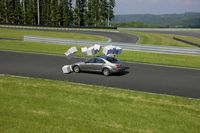Road Safety From The Perspective Of Mercedes-Benz: A Comprehensive Approach
MULGRAVE, AUSTRALIA - October 13, 2010: Mercedes-Benz's comprehensive safety philosophy is all about avoiding accidents and mitigating their consequences. Here, Mercedes-Benz is showcasing the full extent of its safety research initiatives, including a variety of experimental vehicles and simulators, which come under the umbrella of the company's real-life safety concept.
Good visibility and minimising driver fatigue have been key principles behind all vehicles from the Mercedes-Benz brand. The company's engineers have coined the term "driver-fitness safety" for this. Aspects such as ride and seating comfort, quiet running, the headlamp and windscreen wiper systems as well as easy, safe operation play a significant role here. Assistance systems are increasingly important these days, providing support for drivers as they perform a complex activity. In the current E-Class, for example, proven technologies like ABS, ESP and Brake Assist work alongside a dozen new or enhanced driver assistance systems to help prevent accidents and reduce their impact. These range from drowsiness detection to automatic full brake application on recognising that there is acute risk of a collision, from Adaptive Highbeam Assist to the Active Bonnet.
Active Blind Spot Assist warns the driver when changing lanes if there is a risk of collision due to another vehicle in the neighbouring lane being in the so-called blind spot of their exterior mirror. If the driver ignores the warning and the vehicle in the adjacent lane comes dangerously close, Active Blind Spot Assist intervenes. By applying braking force to the wheels on the opposite side of the vehicle, a yaw movement is created which counteracts the collision course.
Active Lane Keeping Assist is now also linked to the ESP for the first time. This Page 3 system kicks into action if the Mercedes vehicle inadvertently drifts over a solid line to the right or left of a lane. In this case, Active Lane Keeping Assist uses the ESP to brake the opposite wheels and thereby prevent the vehicle from crossing the line. A display on the instrument cluster warns the driver at the same time.
In 2002 Mercedes-Benz became the first automotive brand to offer the anticipatory occupant protection system PRE-SAFE which takes measures to protect the occupants of the vehicle if there is an imminent risk of an accident. This multi-award-winning technology, which comes as standard on various Mercedes model ranges, takes its lead from nature in that PRE-SAFE activates protective measures for the car occupants as a precaution, just as living things react instinctively and search for cover when they are in danger.
The aim is to prepare the occupants and vehicle for an imminent collision so that the seat belts and airbags are able to fulfil their protective function to the full during an impact. What's more, the PRE-SAFE protective measures are reversible: if the accident is averted, the advance tensioning of the seat belts is halted automatically and the occupants are able to reset the positions of the seats and the sliding sunroof.
Here, Mercedes-Benz is using three simulators to demonstrate the effectiveness of innovative safety systems. For the first time for this purpose, the PRE-SAFE demonstrator uses a linear motor to accelerate the vehicle cabin to up to 16 km/h within a distance of four metres. This corresponds to an acceleration of two g, i.e. twice freefall speed. After around 1.2 seconds the cabin impacts the specially designed hydraulic shock absorbers. In the interim the occupants not only experience the effects of the PRE-SAFE functions at first hand, e.g. belt pretensioning, NECK-PRO and the inflatable side bolsters on the seats, but also the restraining effect of the seat belts during the impact. The assistance systems simulator enables testers to discover in a realistic way how a range of assistance systems work in an S-Class under different road and traffic conditions. The ATTENTION ASSIST simulator reconstructs the effects of driver fatigue.
Thanks to demo vehicles in the outdoor area, there will also be an opportunity to Page 4 experience how Active Lane Keeping Assist and Active Blind Spot Assist work in reality, as well as how rear-end collisions can be avoided with the help of BAS PLUS and the PRE-SAFE Brake.
The engineers at Mercedes have plenty of other ideas to improve safety too. With the help of the ESF 2009 experimental safety vehicle (ESF is the German abbreviation the brand uses for these vehicles), Mercedes-Benz reveals what its safety experts are researching and working on at the present time, often based on a timeframe extending many years into the future. Like its historic predecessors, the ESF 2009 illustrates trailblazing innovations in the field of safety and makes the progress achieved clearly visible. These amazing but by no means crazy ideas include inflatable metal sections which give more stability to structural components within fractions of a second, as well as the so-called "braking bag". This airbag housed within the vehicle floor is deployed when a crash is deemed to be unavoidable and uses a friction coating to support the vehicle against the road surface.



